Dieting: For body composition changes.(Part 2)
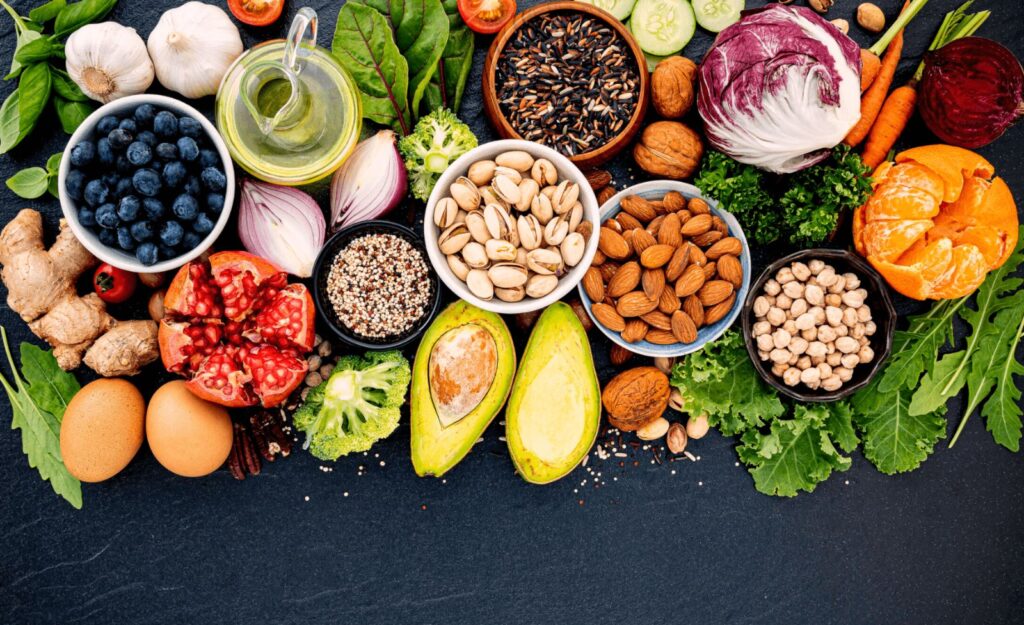
Hey everyone, welcome back to my 3 part series.. where I talk a little about dieting properly for body composition changes. Today the focus is on nutrient timing and food composition. In the last article I went over calorie balance and macronutrients. The 2 most important pillars on the diet principles pyramid. Here is a link to the article for those who would like a refresher before reading today’s article https://www.theavgguysnutritionandexerciseguide.org/uncategorized/total-nutrition-part1/. Today I will be talking about the next 2 most important pillars holding the diet principles pyramid together: Nutrient timing and food composition. Let’s take a deep dive and see what these diet pillars really consist of.
Nutrient timing.
Just like the last two principles make up a percentage of the total results you can expect from following all of these principles, nutrient timing occupies a space too. It makes up 10% of the total results you can expect to achieve when followed correctly. Over a few years of training this could make a big difference in your physique and training goals.
Nutrient timing is made up of:
- Meal size.
- Meal number.
- Meal macronutrient composition.
- Meal composition.
- Meal spacing and timing around a bout of exercise or session.
Meal size.
Meal size means how many calories are in 1 meal. This is important to take into consideration as depending on how many calories you have in a meal could get you very different results. For example if you are training at 12 noon it is probably a wise idea to consume a meal containing a good portion of your daily calories before training. This will give you the energy to train.
Post training meal gains.
Likewise after training it is wise to consume a sizeable meal as our body’s are primed to absorb all of the carbohydrates, protein etc. Why? We have trained our muscles, we have partly damaged them. Now they need nutrients to recover. We want to consume a large amount of calories here as our bodies are in a prime state to absorb more carbohydrates and nutrients than normal. Due to increased levels of insulin. Later on in the day, you can consume smaller meals including protein for good protein synthesis. These meals don’t need to be as large as our body as already absorbed a lot of it’s needed carbohydrates from the post workout meal and maybe the meal after this one too.
Meal number.
Meal number are how many meals you consume throughout the day. This one is important as we want to include enough meals for good protein synthesis as well as having a steady flow of nutrients to the body throughout the day. If we had too few meals our body may start to use amino acids for energy if leaving large gaps between consuming protein. Or it might make it harder to hit the needed daily calories during a hypercaloric diet.
Meal macronutrient composition.
Meal macronutrient composition means how much protein, carbohydrates and fats you are consuming in a meal. This is important as cosuming different amounts of macronutrients within a meal will get your different results. Like I mentioned in the last article consuming high glycemic carbohydrates 1- 2 hours before training is a good idea as these carbohydrates will quickly be absorbed by the body. Now you have stored glycogen in your muscles and are ready to train. But if you consumed a meal high in fat or fiber within the same timeframe, digestion and absorption will be slowed leading to poorer gym performance. Not what you want!
Protein in small but frequent doses.
Another thing I could say is that you want to have enough of the macronutrient protein in each meal you consume for optimal protein synthesis throughout the day. If you don’t consume enough protein in one meal but over consume in another, your body may not use all of the amino acids from the 2nd meal and so is not used as what it should be for.
Meal composition.
Meal composition are the types of foods in a meal. This influences our digestion, absorption of vitamins and minerals, feelings of satiety or of gastrointestinal distress. Some foods are also better suited for certain occasions even when they contain the exact same macronutrients and calories. An example could be a protein shake and a piece of fruit over roast chicken and potatoes when you are busy and don’t have time to cook.
Meal spacing and timing.
Meal spacing and timing means how far apart your meals are from 1 another and how close they are to a bout of exercise. If you ate just a few minutes before training, your missing out on refilling/topping up your muscle glycogen stores to be ready for exercise. You may experience gastrointestinal distress during exercise, overall leading to a poor training session. So as you can see all of these points come together to either get you great results or poor results. How you set up your diet and implement them will determine your results.
Nutrient timing effects: Meal timing and sizes for satiety and diet adherence.
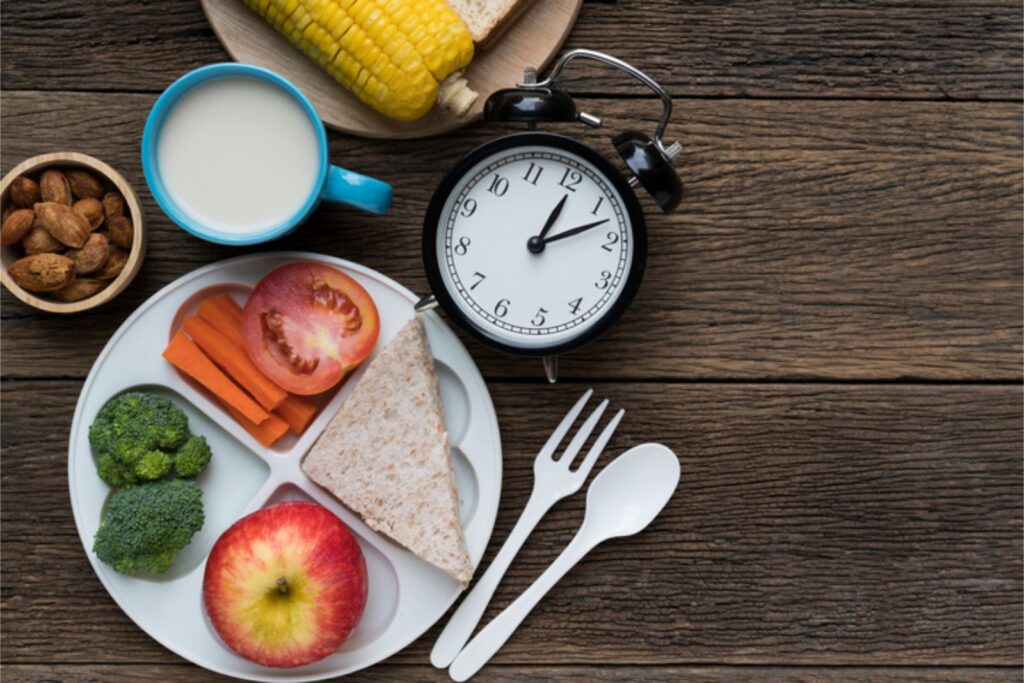
If your not following these correctly, you can lose as much as 10% from your total progress. This could mean when massing or gaining muscle eating too few and large meals. When dieting to lose fat, leaving too much time between meals leading to more hunger, stress and fatigue. This has a knock-on effect with the observation of decreased performance and muscle retention. Eating too much food all at once may mean you suddenly binge, experience food cravings leading to unhealthy eating habits which last after a dieting phase.
Small is usually not a good thing.
Eating too few meals means you may feel like you have never quite eaten a meal and wish to consume more. A solid recommendation is to consume anywhere from 4-8 evenly spaces meals with equal calorie amounts for best diet adherence and results. Consuming a smaller meal first and increasing meal size while consuming more fats and protein the later on in the day when you are resting is a solid approach. Both for the constant supply of nutrients and diet adherence.
Digestion rates and meal timing.
When we consume food, our GI tracts takes a little bit of time to absorb this food. But did you know that certain foods absorb faster depending on their macronutrient make up? For example, whey protein is a quick absorber, being absorbed by the body in 1 hour. Compare this to chicken breast (2-4hrs) and casein protein which can take up to 7+ hours to be fully absorbed. Carbohydrates are the same with some like white basmati rice or low fat kids cereal being absorbed very quickly. Some fruits take a few hours to fully absorb.
Now you know a little more about fat.
Did you also know that fat, can slow down the absorption of protein and carbohydrates. This is a good thing if you consume a meal with fat just before bed. While your asleep your providing your body with a steady flow of nutrients. But it should be avoided in the post training window as we want the protein and carbohydrates we consume here, to be absorbed as quickly as possible. High fat meals are better consumed with an adequate amount of protein for better per hour amino acid availability during the prolonged digestion and absorption window.
Meal timing.
We should consume anywhere from 4-8 evenly spaced meals throughout the day. Why? Well for the fact we want a steady flow of nutrients to the body throughout the day. After your last meal containing protein has been digested and absorbed, the body will start to use amino acids as an energy source if no other sources of energy are present. Remember carbohydrates are it’s preferred source of energy. This is not a good thing if we are in a caloric deficit and trying to lose body fat. The chances of losing muscle mass are increased. So make sure to consume enough protein evenly spread throughout the day to avoid this from happening.
Meal macronutrient makeup matters.
Macronutrient makeup of foods also should be paid attention to together with meal timing. If you consume a meal low in fat, nutrients will be absorbed faster. But unless you are eating enough meals throughout the course of the day, you run the risk of letting the body use amino acids as energy if no other energy source is present. Why? Because the protein is absorbed quickly since the meal we consumed contained little fat or fiber. If our next meal is in another 5 hours that’s a long gap between feedings. The body will almost surely start to breakdown amino acids to be used as energy since it’s not acquiring any new nutrients during these 5 hours. A good strategy you can use when eating just 4 meals over each day is to make sure to include some fats for prolonged digestion and absorption times. Now it works in our favor!
Protein timing.
The human body is constantly breaking down and rebuilding its structural and functional proteins. Ingested protein supports the homeostasis of these structures. If there is no ingested protein readily available to use by the body, it will break down muscle tissue to acquire its amino acids. In a hypercaloric diet, ingested protein supports muscle growth. During a hypocaloric diet, it supports muscle retention.
Protein in equal doses for best results.
We should aim to consume protein in even amounts throughout the day (1/4- 1/8 per meal) for the better absorption of all protein ingested. If we consume protein in uneven amounts, maybe only a 1/4 of it will be used for skeletal muscle growth and maintenance (the superficial muscles we can see) while the rest is used for energy or lost due to urine and sweat excretion. Over-consuming protein in one meal is not a deal breaker, as some compensation will occur in the following meal. Protein consumption on a hypocaloric diet should be even, up to 1.2g per ib of bodyweight is recommended. On a hypercaloric/muscle building diet up to 0.7 per ib of bodyweight is recommended.
Carbohydrate timing and portioning.
Ingested carbohydrates support the body’s immediate energy needs and aid in glycogen replenishment up to it’s max rate. Once reached, all extra carbohydrates consumed are converted to fat as there is a surplus of calories the body doesn’t need for skeletal muscle growth/maintenance and topping up glycogen stores. Protein should be ingested together with carbohydrates, so the carbohydrates are better absorbed and used for energy. The protein used for muscle building/maintenance. If you consume few carbohydrates in 1 meal, this can be made up in the next meal where carbohydrate absorption is more pronounced. But try to consume meals with equal enough carbohydrates for more consistent results as well as more regular blood sugar levels.
Structuring your meals around physical activity.

- Pre-training.
- Intra-training.
- Post-training.
- High activity non training periods.
- Low activity training periods.
- Bedtime.
1. Pre-training.
A carbohydrate rich meal should be consumed 4hrs – 30 minutes before training to regulate blood glucose stores and fill glycogen stores. It also helps to support high-intensity activity and signals to the body to become anabolic whether that is muscle retention or growth. Don’t ingest a fat heavy meal as digestion and absorption will be slowed down. Eating a large meal is also not recommended as all of the blood will go to the muscles, heart and lungs being trained. No blood will be available to help digest the food eaten which can lead to feelings of nausea and vomiting.
Timing is everything.
It’s fine to eat more slow digesting carbohydrates and protein 4 hours before training as enough time is given for the digestion of this food. If eating closer to training, eat smaller meals with minimal fiber and fat for the quick digestion and absorption of carbohydrates and protein. You may also find it helpful to consume a carbohydrate drink during training to keep blood sugars constant and support performance.
2. Intra-training.
Most training which lasts an hour or less heavily relies on stored glycogen. If training more than an 1 hour and 30 minutes or the training done is very intense, a carbohydrate drink is recommended to consume during training. I know personally from training over 1 hour 30 mins my body is starting to tire and some fasting acting carbohydrates are a great boost. So you can power through the rest of your workout.
3. Post-workout.
Training induces the release of catabolic and hormonal and intracellular conditions if no new nutrients are introduced. For the next 3-6 hours following training, muscles are very sensitive to carbohydrate intake and the replenishment of glycogen stores. Protein does not play a role in this, but should be consumed to keep protein absorption consistent throughout the day. Consume fast-acting carbohydrates and proteins to avoid gastronomical distress and for increased anabolism. You should consume a lot of carbohydrates in and around your training to support training while saving your fat intake for later on in the day. Food containing fat is usually tastier too so we can consume this when resting/relaxing for more enjoyment and diet adherence.
3. High activity non-training periods.
This can include anything from construction jobs or walking around while at work or in the shopping center. Carbohydrate intake should be increased to support energy needs as calories are burned. If not consuming enough carbohydrates at this time, this may impact on your training later on as your body has no or not a lot of available carbohydrates to be used for exercise.
4. Low activity non-training periods.
Unlike in point 3, here we are not burning a lot of calories so carbohydrate and fat intake can be lower. Make sure to ingest some protein so amino acids are not used for energy instead of muscle building/retention.
5. Bedtime.
In the ideal world, consuming some protein right before bedtime is optimal for better amino acid availability throughout the night. Consuming some fat at this time is not a bad idea either, helping slow down the digestion and absorption of protein so you get a more consistent and longer duration of these during the night. Consuming fat right before bedtime may cause some sleep disturbances so make sure to test and see what works well for you. Remember the diet you can stick to is the one that will get you the best results.
Nutrient timing.
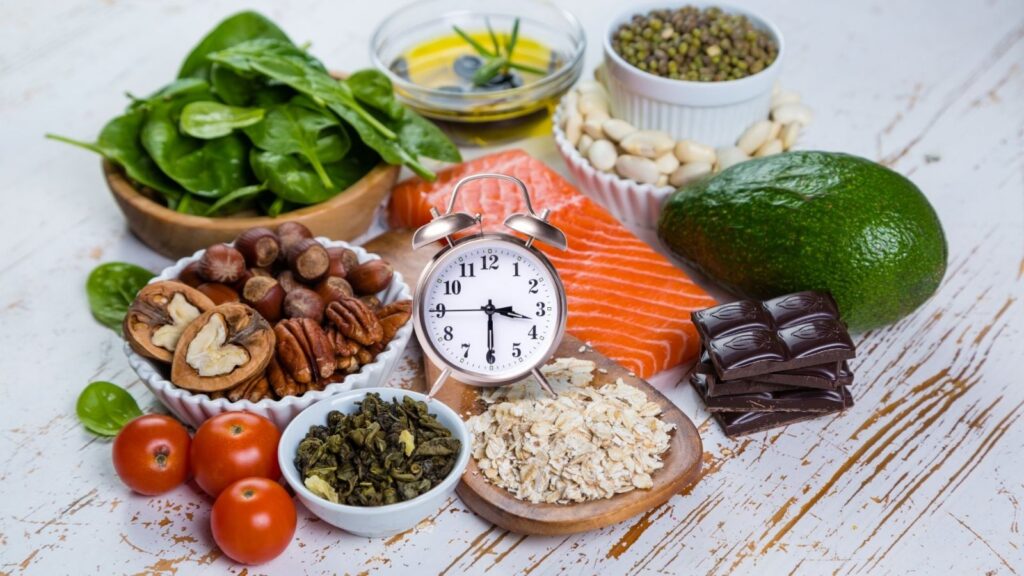
Nutrient timing can make a 10% difference in your physique and strength goals. Over the long-run, this can make a big difference in progress observed. It is made up of:
- Meal size.
- Amount of meals consumed.
- Meal macronutrients.
- Meal composition.
- Meal spacing.
- Timing around physical activity.
1. Meal size.
This is the number of calories contained in a meal. It can be manipulated as you want for the desired result. Like eating larger meals closer to training to support training needs. While eating smaller meals closer to bedtime to avoid sleep disturbance during the night.
2. Amount of meals consumed.
Amount of meals consumed is quite self-explanatory. We know eating between 4-8 meals per day is optimal for constant amino acid availability in the blood stream. Find a meal number within these guidelines that fits your schedule and you will be onto a winner.
3. Meal macronutrients.
Meal macronutrients are the number of macronutrients within a meal you consume. I earlier touched on this point but we can consume more carbohydrates before and after training to support training and recovery needs. As well as the increased blood insulin levels observed when consuming more carbohydrates in the subsequent hour and 3 – 6 hours after training. Eating more fat and protein heavy meals further away from training supports the prior point while we hit and continue to hit our fat and protein needs for the day.
4. Meal composition.
Meal composition means what kinds of proteins, carbohydrates and fats the meal is made up of. Is the meal made up of proteins with a complete amino acid profile or 2 incomplete protein sources with half of the amino acids to make a complete protein source? An example of this are beans and wholegrain bread. Are the carbohydrates of the high glycemic variety where they can be ingested quickly by the body? Or are they slow digesting like oats and have a low glycemic index value? Lastly what kind of fat makes up your meal? It could be monounsaturated fat which is the most healthiest and supports performance and general health. We also have Polyunsaturated, saturated fat and trans unsaturated fat. Trans unsaturated fat being the most unhealthiest of all and should largely be avoided if having body composition goals in mind.
5. Meal spacing.
Next, we have meal spacing, which means how far apart you eat your last meal from your current meal. We know if we wish to avoid the breakdown of amino acids for energy use, we should eat a meal every 2-3 hours. Containing all of the essential amino acids to support muscle gain and maintenance.
6. Timing around physical activity.
Meal timing around activity as well as what is the macronutrient make up of that meal is important. Depending on the macronutrient make up of the meal will make it more suitable to be eaten close or far from training. Eating a few hours before training? In that case a slow digesting carbohydrate source like brown rice or oats would be ideal. But if you eat these foods too close to training your could experience gastrointestinal distress. As well as not allowing enough time for the nutrients to absorb and converted to glucose for activity.
Snap, crackle and pop.
A high glycemic carbohydrate source like white bagels or kid’s cereal works wonders when eaten close to training (1 hour). Or consumed after training when blood insulin levels are temporarily elevated. But if you consumed this meal a few hours before training you will have a spike in blood sugars for a short time. But this energy might not be available for training later on when you need it. So you can see being conscious of your food choices paired with the timing of these will either get you great or poor results.
Food composition.

Food composition makes a 5% difference in your body composition goals. It is more important for general health. But if your general health is not right, then chasing physique and strength goals are definitely unwise in my opinion. Food composition consists of what nutrition do you get from the macros you consume? How is the food used and digested by the body? Can your body efficiently digest the food consumed? How long does it take to digest the food, vitamin, mineral, fiber and phytochemical content? Let’s start with protein composition, this one being quite important if you have physique and strength goals to achieve.
Protein composition and protein source digestibility.
There are 3 main aspects to protein composition. They are the quality of the protein, does it contain all essential amino acids or is it an incomplete protein? How well can your body can digest and absorb the protein? Lastly the makeup of other micronutrients within the protein source. Whey protein is a great protein source as it contains all of the essential amino acids needed by the body. It is digested and absorbed quickly too.
Incomplete protein.
Compare this to protein acquired from wholegrain pasta. It’s not a complete protein and must be paired with another incomplete protein to make a complete protein. But what wholegrain pasta has over whey protein, are more micronutrients. If consuming it paired with another incomplete protein further away from training it may be better than whey protein. Why? It takes longer to digest and absorb which has it’s benefits while dieting. We can also go without eating any protein for a longer time period since we are not in danger of using amino acids for energy. Due to the slowed digestion and absorption rate. It also contains more micronutrients for better general health and recovery from exercise. Paired with another incomplete protein, it now contains all of the essential amino acids we need to feed our muscles.
Protein source digestibility.
This boils down to, how well the protein you consume is digested by the body. Not all types of protein are created equal in terms of digestibility as well as quality. Animal proteins such as dairy, eggs and isolated protein powder are the most easily absorbed by the body. Meats and soy come in at second place. Protein sources derived from plants are not digested as well due to cellulose. This is part of the plant wall that can’t be broken down by the gut.
Protein source quality.
A complete protein contains all 9 essential amino acids needed by the body. An example of a food containing all essential amino acids are whey protein or eggs. Both of these foods have a protein digestibility – corrected amino acid score (PDCAAS) of 1. This is the highest score a food can rank for protein quality. Other foods include casein and soy protein respectively.
Protein source micronutrient composition.
As humans, we need ample amounts of vitamins, minerals and fiber everyday to support general health. But they are also needed for body composition and performance goals. Phytochemicals are found in plants, though not essential for general health or performance but they help to boost these by a small degree. Animal proteins such as red meats contain B12 and iron which you can’t acquire from plant proteins. B12 is very useful as it helps to convert carbohydrates into glucose which can be used for energy and to maintain energy levels. Plant protein is an inferior protein source compared to animal proteins, due to containing less quality protein, less healthier fats and fiber which makes it harder to be digested by the body.
Carbohydrate composition.
This includes the amount of time it takes to digest the carbohydrate source as well as the nutrient density of the carbohydrate source. The Glycemic Index rates carbohydrates based on how quickly they are absorbed by the body into the bloodstream. Carbohydrates with a high score digest quickly into the blood stream. We notice a quick spike in blood sugar levels. Examples could be kid’s cereal or another refined carbohydrate like white rice. The highest ranking carbohydrate is pure dextrose powder or glucose with a score of 100. Gatorade takes second place with a high score of 90. White potatoes come in third place with a score of 85. This is the average score of all cooking methods.
Low glycemic index carbohydrates and the glycemic index.
On the other end, we have foods such as oats and brown rice which take longer to digest. Energy is released more gradually and blood sugar levels are kept consistent. These carbohydrates score lower on the index. With oats scoring a 55 and brown rice with a score of 50. Processed carbohydrate sources have a higher value due to containing less fiber which is removed during processing. Eating other foods with a carbohydrate source can change it’s index value. This is because of the presence of fat, fiber and protein which all slow digestion rates. This should be taken into consideration when designing your diet for better performance in the gym or better per hour amino acid availability.
Carbohydrate source recommendations for pre-workout, intra-workout and post workout meals.
Post workout.
Carbohydrates consumed here, should be absorbed quickly into the body and cause no to minimal gastrointestinal distress. Their goal is to refill glycogen stores in preparation for physical activity and keep blood sugar levels constant during exercise. Consuming something like Gatorade 30 minutes before exercise is a good idea as the liquid makes for easier absorption as well as containing no fiber. If you are training later on in the day, consume a slow digesting carbohydrate source such as wholegrain bread and a protein source like chicken which will slow digesting makes more sense. This allows for a constant supply of carbohydrates. The protein takes longer to digest so we see a steady flow of amino acids to the body during these time. If you are eating a few hours before training, you should consume more total carbohydrates to support basic function and training later on.
Intra – training meal.
This should always be a carbohydrate source ranked highly on the Glycemic Index. Slow digesting carbohydrate sources will only cause gastrointestinal distress, affecting your training. A great example would be to consume a sugary-carbohydrate liquid such as Gatorade or pure dextrose powder which are absorbed very quickly by the body and converted into glucose.
Post – training meal.
During this time the body is screaming out for carbohydrates after the demands of training and the depletion of glycogen stores. There is a high – resensitization rate as carbohydrates are converted to glycogen. Because of the high resensitization rate, fat gain is minimal. Look to consume high index source carbohydrates such as kid’s cereal and skimmed milk which are absorbed very quickly by the body due to minimal fiber and fat content.
Consume carbohydrates when needed.
The further you are away from training you can increase your fat intake as well as consuming more slow digesting carbohydrates such as brown rice. By this point, glycogen stores have been refilled and carbohydrate sensitivity has decreased. After this, consuming enough carbohydrates paired with a protein source is a good idea for the better absorption of both. After consuming the high glycemic carbohydrates right after and the following hours after training, your body has enough stored muscle glycogen for the next training session. Consuming more carbohydrates than your body needs at this point will just lead to fat gain. Though carbohydrates are not the devil here, as many believe. It’s more so the fact of eating in a calorie surplus which can be achieved by carbohydrates, fats or protein.
Time between meals.
If you have a large gap between meals due to work or other constraints, consume slow digesting carbohydrates like wholegrain bread combined with a protein source (turkey or beef), a fat source (olive oil or a nut butter) and some vegetables, (which contain fiber). These all help to slow digestion leading to the steady release of nutrients, protein and energy.
Glycemic index values and daily eating.
There is a belief among some people, that carbohydrates ranking high on the glycemic index lead to increased fat gain due to insulin secretion. There may be some truth to this but increased insulin secretion can also be observed with low ranking glycemic index foods too such as skimmed milk.
It’s not all about how fast or slow a food absorbs.
The glycemic index can not be used to rank how healthy a food is on it’s own. It’s more how satiating a food is which will lead to feelings of fullness quicker as the stomach signals to the brain we are full, so we stop eating. Once we feel full, we experience less cravings and don’t want to eat anymore. White potatoes rank highly on the index but are very satiating. Macronutrient and calorie content as well as digestibility will always be more important compared to how high or low a food ranks on the index. High ranking glycemic foods are useful when consumed post and intra workout for fitness and health goals. Long story short, no matter if the carbohydrate source ranks high or low on the scale it has it’s place in your diet if used correctly to support your goals.
Carbohydrate source micro density.
The more vitamins, minerals and phytochemicals a carbohydrate source contains, the higher value is it’s compositional value. A carbohydrate sources such as dextrose powder is pure carbohydrates without any vitamins, minerals and phytochemicals. Though it has it’s place in a diet, such as being used as an intra-workout performance booster for readily available energy converted from glucose, it for sure should only make up but a small portions of your overall daily carbohydrate consumption. Due to it’s low vitamin and mineral content. But as an intra-workout shake it works very very well to support training.
Micronutrients are important.
The rest of your carbohydrate sources should come from wholegrain varieties such as wholegrain bread, pasta, rice, oat, potatoes, fruit and vegetables which all content an abundance of vitamins and minerals as well as carbohydrates. It should also be noted if you like to eat a ketogenic diet, which comprises of just proteins and fats, you will miss out on essential vitamins and minerals. Due to having no fruits, vegetables or wholegrains in your diet.
Fat composition.
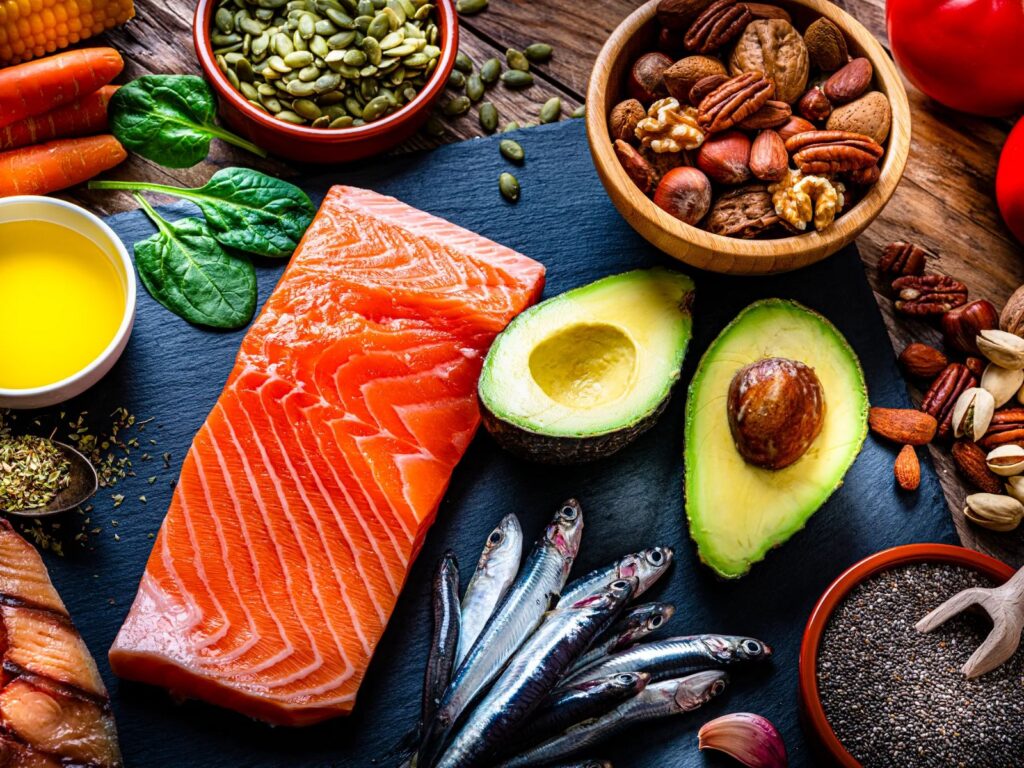
Fat falls under 4 different types such as monounsaturated, polyunsaturated, saturated and trans unsaturated fat. Each one has its own effect on general health and performance. Let’s dive into each one and find out a little more.
Monounsaturated fat.
This is the most important fat for general health and body composition. Foods which come under this category include avocados, canola oil, olive oil and nuts. All of these foods contain lots of vitamins, minerals and antioxidants which help fight inflammation induced after exercise. These fats support lean and strong physiques and should make up a large portion of your fat intake.
Polyunsaturated fat.
These type of fats support performance though don’t have any real benefits for general health. These include vegetable oils, like canola oil and sunflower oil, walnuts, fatty seeds, fish which contain essential fatty acids (Omega 3’s) and grass fed animal meat. These foods contain Omega 6’s and 3’s with Omega 3 largely being under consumed by a lot of people due to people not consuming much of these foods. If this is the case, you should supplement with an Omega 3 fish oil capsule.
Saturated fat.
This fat comes from animal sources such as eggs, dairy, meat and coconut oil. There still needs to be more research done on these types of fat. Some say they could support anabolic hormone levels. Current research says to limit these types of fat in your diet.
Trans unsaturated fat.
These once natural fats have been chemically modified to help prolong the shelf life of foods as well as making transferring them easier. These fats are the worst kind of fats you can consume. If you can help it, don’t consume them at all. They seem to increase fat tissue as well as reduced levels of muscle mass. They also increase the likelihood of cardiac and systematic diseases.
The micro-density of different fat sources.
Fats do not contain any other types of vitamins. Though fats help to transport fat soluble vitamins though these vitamins don’t come from fat itself but other food sources. Fats are like the bus for the school children going to school. It won’t directly help them learn and know more Spanish, but it helps get them to school, which is where they need to be if they want to know more Spanish. The general recommendation is to acquire most of your fat from monounsaturated varieties, closely followed by polyunsaturated fats. Consume moderate amounts of saturated fat while avoiding at all possible trans unsaturated fats.
The micronutrients.

Micronutrients are important for the normal function of the body and help with the absorption and digestion of food. As well as being responsible for converting glycogen into energy and the production of important hormones like testosterone.
Vitamins.
Micronutrients include the vitamins A, D, C, E, K and B complex vitamins. Water soluble vitamins C and B complex vitamins are found in most fruit, vegetables and grains. Except B12 which is found in dairy, eggs, seafood and meat. Fat soluble vitamins A, D, E and K are found in vegetable oils and dairy products. Most of the vitamins are converted to an active form when they enter the bloodstream, where they help to regulate many bodily functions such as vision, energy metabolism and bone formation. Fat soluble vitamins must bind to fat molecules in the GI tract to be absorbed.
Variety and balance.
Diets low in fat lead to fat soluble vitamin deficiencies. To avoid vitamin deficiencies consume a range of fruits, vegetables, dairy, meat, wholegrains, protein and healthy fats like monounsaturated, polyunsaturated and saturated fats. Even the vitamin and mineral content of fruit and vegetables differ. You should consume a variety of all to acquire all needed vitamins and minerals. Vitamin supplements can be useful during a hypocaloric or fat loss diet, acting as an insurance policy against vitamin deficiencies. But long-term dependence on them is not recommended. Whole food is what we are meant to eat and we should stick to this.
Minerals.
These are chemical elements that are needed by the body for basic health and function. They include calcium, phosphorus, magnesium and iron. Minerals which are needed in only small quantities because they are potentially toxic in larger doses include zinc, copper, manganese, iodine, selenium, molybdenum and chromium. Electrolytes are the most important for performance and physique goals. Sodium, potassium, chloride, calcium, iron and magnesium can impact the function or performance of cells due to changing cell membrane permeability. These help with neuronal firing of the central nervous system. They also help with muscular contractions of skeletal, cardiac and smooth muscle tissues. A very important part of your diet allowing you to train with the needed intensity and volume to see progress.
Electrolytes.
Electrolytes control hydration and blood PH but can only affect blood PH if there is a large imbalance. They should be replaced during and after exercise. Consuming extra electrolytes is very important when exercising intensely, exercising for prolonged periods of time, in hot and humid conditions or when sweating a lot. The body needs electrolytes to return to homeostatic or it’s normal healthy functioning condition. Electrolytes needed just for normal everyday function can be acquired from foods.
Just a small amount goes a long way.
Sodium and chloride are found in table salt and seasonings. Sodium helps with hydration by drawing and keeping fluid in the cells. Magnesium is found in spinach, beans, shellfish and milk. Magnesium helps to maintain muscle and nerve function, blood sugar levels and blood pressure as well as helping to create protein, bone and DNA. Calcium is mainly found in dairy but can also be ingested from almond and soy milk as well as green leafy vegetables. It keeps bones and teeth strong and hard, helps the brain send messages to different muscles in your body. Potassium, which is needed for proper hydration is found in potatoes and banana’s but also in most fruit and vegetables. Potassium helps to move waste materials within your body to be cleaned as well as transporting nutrients around the body. It keeps your heart, muscles and nerves functioning well too.
Build an iron physique with iron.
Lastly we have iron. There are two types. Non-heme iron and heme iron. Non- heme iron needs to be broken down or reduced before it is absorbed by the body. Heme iron, does not need to be reduced, so more is absorbed. You can find it in meat, fish and poultry. Non-heme iron is found in wholewheat and dark green vegetables.
Iron deficient anemia.
A lot of people nowadays are iron deficient. Meaning they have a condition called iron deficient anemia. This reduces the amount of red blood cells produced in the body meaning less oxygen supplied to the muscles. Muscles need oxygen to contract during exercise, so as you can imagine being iron deficient will definitely not help you with your body composition goals. Anemia hinders recovery and prevents high volume training which we know is needed to maintain muscle mass during a hypocaloric diet or grow more muscle tissue during a hypercaloric phase. If you are iron-deficient, are prone to iron deficiency, don’t consume enough iron products or under eat heme iron…supplementing with an iron supplement will work wonders.
Fiber.
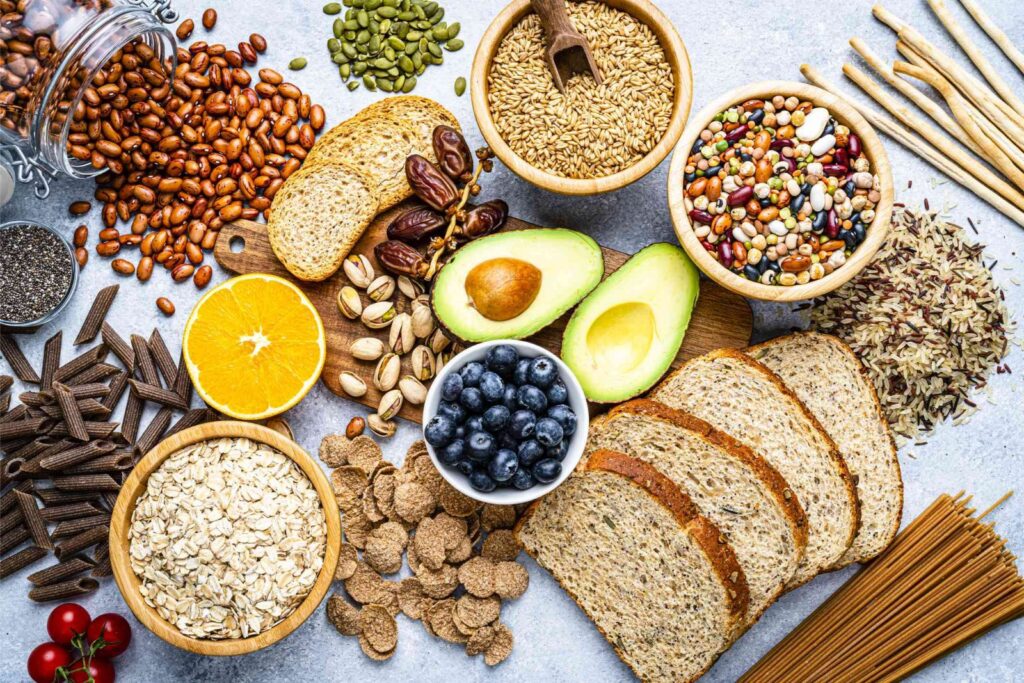
Fiber is not essential for general health and does not help a lot with performance but during a dieting phase or when trying to lose body fat it has it’s place in your diet. Why? Fiber makes us feel fuller sooner so we stop feeling the urge to eat food. Important when dieting as we are purposely trying to consume less calories than our body needs to lose weight. It also helps with bowel movement regularity as well as being healthy for the heart.
Fiber used as a tool.
Fiber helps to slow down the digestion of foods, which leads to more steady blood sugar levels. When coupled with a high glycemic index carbohydrate it helps to slow down the digestion and absorption of this carbohydrate. This can be useful if going without food for a long period of time during the day. A example could be during work when your busy and don’t have much time to consume a meal.
Phytochemicals.
Lastly we have phytochemicals. These like fiber are not essential for health but they may help us avoid diseases such as cancer, heart disease and help improve overall body function. You can get all of your phytochemical needs from 1-2 cups of fruit and vegetables per day. Make sure to include a range of fruit and vegetables as well as green leafy vegetables.

Alright everyone, so after reading this article you should be in a better place in terms of your knowledge on nutrient timing, food composition, vitamins and minerals etc. Use this knowledge to enhance your training and body composition results so you achieve what you set out to do. If you found this helpful please follow this blog for more educational content around nutrition and exercise as well as my social media accounts where I post more video style educational content. I would also like to mention, I have learned a lot of information from this website: https://rpstrength.com/. If you would like to check out their website, they have a nice blog about nutrition and training. Happy training everyone!
